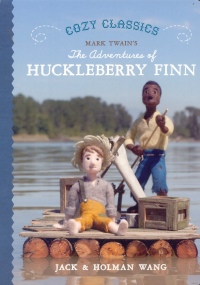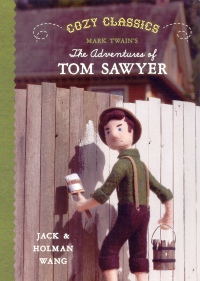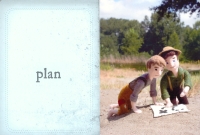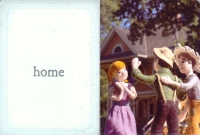| ________________
CM . . .
. Volume XXI Number 39 . . . . June 12, 2015
By the time I was in grade 4, I had read most of the classics, cover to cover, including Ivanhoe, Robinson Crusoe, A Tale of Two Cities, Moby Dick, Gulliver’s Travels and Huckleberry Finn. Lest you mistakenly think that I was some sort of child prodigy, I need to add that my reading was all in the form of “Classics Illustrated” comic books. If I were a newborn or toddler today, however, thanks to the collaboration of twin brothers Jack and Holman Wang, I would not have to wait until I was able to read a comic book to be exposed to many of the “classics”. The pair are the creators of the “Cozy Classics” series, which, according to the website www.mycopyclassics.com, “is a new board book series presenting well loved stories through 12 child friendly words and 12 needle felted illustrations.”
A “fresh take” does not always equate with a “better” take, and the two Twain-based board books fail badly as board books even though the website further asserts: “The books work as word primers, even without any reference to the original stories.” Design-wise, each pair of facing pages provides a single word of text on one page and a full-colour photo of a needle felted illustration on the other page, with that illustration ostensibly providing the visual “definition” for the one-word text page. The website suggests that the audience for the “Cozy Classics” is “children aged 0+” while the promotional material from Simply Read Books which accompanied the review copies suggested the range of “0 to 3". However, in most instances, the illustrations are much too complex for the intended young audience to glean the meaning of a word from its accompanying visual. For example, the illustration for the word “river” in Huckleberry Finn shows two people on a raft on a body of water with blurred trees in the background. If I’ve never before encountered the word “river”, what am I to take from this picture, especially when my eyes are initially drawn to the boy sitting on the raft? Similarly, in Tom Sawyer, the language acquiring toddler is to interpret an illustration of two boys greeting a young girl, with the background being a portion of a blurry house surrounded by trees, as offering the meaning of the word “home”.
Should my (or a toddler’s) telling not seem to follow the plotline of Twain’s original story, don’t worry as the website suggests, “If you, as a parent, can fill in some of the original tale as part of the reading experience, so much the better!” And if parents have never, themselves, read these classics, then the website advises, “If you need a little help, just use the brief synopsis on the back of each book or the longer synopses [available on the website].” According to the series’ website, “Each word is carefully selected [emphasis mine] to relate to a child’s world, such as ‘friends’, ‘sisters’, ‘dance’, ‘muddy’, ‘boat’, and ‘leg’.” The sunrise/sunset silhouetted person referenced in my retelling was intended to illustrate the word “free”. How that word relates to a child’s world is unclear to me. “Go!” is a simple word, but not one that is easily rendered visually, and I suspect most toddlers will, instead, use the word “run” to describe the running figure in Huckleberry Finn. Overall, nouns are somewhat more successfully illustrated in the two Twain-based board books than are verbs and adjectives. As stand-alone art, the individual needle felted illustrations are quite good, and it is unfortunate that they were not used to illustrate an original story. In addition to the Twain-based pair of books, the “Cozy Classics” series includes Pride and Prejudice, Moby Dick, Les Misérables, War and Peace, Oliver Twist, Jane Eyre, and Emma. Not Recommended. Dave Jenkinson, CM’s editor, lives in Winnipeg, MB. As an adult, Dave did revisit virtually all of the original books on which those “Classics Illustrated” comic books were based.
To comment on this title or this review, send mail to cm@umanitoba.ca.
Copyright © the Manitoba Library Association. Reproduction for personal use is permitted only if this copyright notice is maintained. Any
other reproduction is prohibited without permission.
CM Home | Next Review | Table of Contents for This Issue - June 12, 2015 | Back Issues | Search | CM Archive | Profiles Archive |


 The same website also claims that this series breaks new ground in the board book area. “The series will invigorate the genre of the infant primer whose usual concept categories—colors, numbers, shapes, animals, and so on—have become overly familiar. By presenting words that not only introduce simple concepts but create a narrative, Cozy Classics offers a fresh take on the infant primer.”
The same website also claims that this series breaks new ground in the board book area. “The series will invigorate the genre of the infant primer whose usual concept categories—colors, numbers, shapes, animals, and so on—have become overly familiar. By presenting words that not only introduce simple concepts but create a narrative, Cozy Classics offers a fresh take on the infant primer.” Earlier, I had noted that the series’ website had claimed that these 12 words would not only introduce simple concepts, but they would “create a narrative”, by which I assume a “story”. From just looking at the 12 illustrations in Huckleberry Finn, this is the story I would tell: A boy with a hat and a stick on his shoulder is carrying a pail. Maybe he’s going fishing. A man seems to be yelling at him. I don’t know why the man is yelling, but the boy runs away to a lake or river. Who is this Black man? The boy must know him because they are now together on a raft that’s on a river or lake. Now it’s nighttime, and now it’s daytime again, but where has the Black man gone? Why is the Black man now in a house, waving through the window? Who is this new boy? The new boy and the first boy seem to be looking at a treasure map. Now the two boys and the black man are running through a field. Why? And now someone is standing in front of a sunset or sunrise. I can’t see his face, but since he’s not wearing a hat like the two boys were, he must be the Black man.
Earlier, I had noted that the series’ website had claimed that these 12 words would not only introduce simple concepts, but they would “create a narrative”, by which I assume a “story”. From just looking at the 12 illustrations in Huckleberry Finn, this is the story I would tell: A boy with a hat and a stick on his shoulder is carrying a pail. Maybe he’s going fishing. A man seems to be yelling at him. I don’t know why the man is yelling, but the boy runs away to a lake or river. Who is this Black man? The boy must know him because they are now together on a raft that’s on a river or lake. Now it’s nighttime, and now it’s daytime again, but where has the Black man gone? Why is the Black man now in a house, waving through the window? Who is this new boy? The new boy and the first boy seem to be looking at a treasure map. Now the two boys and the black man are running through a field. Why? And now someone is standing in front of a sunset or sunrise. I can’t see his face, but since he’s not wearing a hat like the two boys were, he must be the Black man.